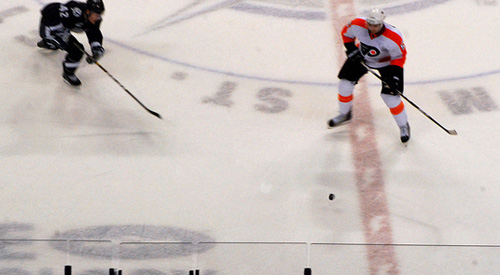
Occupy the Neutral Zone takes over Tampa Bay
The Occupy Wall Street movement has become a global phenomenon, spawning protests in countries from Canada to New Zealand. But there’s another occupy movement that began in Tampa Bay long before anyone thought camping in a public park was an effective way of changing global economic policies.
Occupy the Neutral Zone, better known as the 1-3-1 trap, is coming to a rink near you, ready to suck the life out of your hockey game and bring back painful memories of the time the New Jersey Devils tried to suffocate the fun out of hockey.
This Occupy movement (characterized by no movement whatsoever) was exactly what the Philadelphia Flyers protested in a game last week against the Tampa Bay Lightning. On multiple occasions, the Flyers decided not to skate the puck up ice because the Lightning didn’t seem in any rush to come take it from them.
The referees were forced to blow the whistle multiple times because the game came to an actual standstill.
The proof was on film. The 1-3-1 literally stopped hockey dead.
Strategically, the 1-3-1 is a version of the neutral zone trap that stacks three players in the neutral zone, one defenseman at his own blueline, and leaves one forechecker to pursue the puck carrier. What really drew the Flyers’ ire, though, is that the lone forechecker doesn’t force the play at all. He waits for the defenseman to try to skate or pass the puck through a neutral zone filled with more booby traps than the house from Home Alone.
[php snippet=1]
Ignoring the farce in the Tampa Bay-Philadelphia game, the Lightning don’t utilize the 1-3-1 to torment fans, bring back the dead-puck era, and kill hockey; they utilize it out of necessity.
The Lightning aren’t very good defensively. They’ve allowed the sixth-most goals per game, after finishing eighth on that list last season. Their defence just isn’t very good.
Matt Gilroy and Marc-Andre Bergeron lead the team in plus/minus, but this is on the strength of preferable zone starts. Bergeron starts 70 percent of his shifts in the offensive zone, which tells you about the confidence the Lightning coaching staff has in his defensive ability. The Tampa Bay coaching staff also matches the two defensemen with the team’s strongest forwards, hoping to keep the puck in the opposition’s end as much as possible, limiting the chances their opponents have to exploit the two.
The team’s shut-down pairing, Eric Brewer and Victor Hedman, primarily start in the defensive zone, but are actually defensive liabilities. Tampa Bay allows fewer goals over the course of 60 minutes when the two are off the ice, compared to when they are on.
As a group, the Lightning defense is big and slow, allowing opposing forwards to break in with speed, which often ends in disaster. Overall, the defense doesn’t do a good job of stopping attacking forwards. In order to survive, Tampa Bay needs the 1-3-1.
The 1-3-1 is even more essential considering how porous the Lightning goaltending has been.
Opening night starter Dwayne Roloson’s save percentage sits a mere fraction above .900, well below league average. His goals-against average is above 3.00 and the Lightning have resorted to playing Mathieu Garon with increasing regularity. However, Garon’s performance, while better, is still below league average, as his save percentage is only .907 and his goals-against average in 2.84.
The Lightning cannot afford to rely on their defense and their goalie. If they do, they will lose.
Using the 1-3-1 to aid the defensive effort has proven successful so far this season, as the Lightning sit 6th in the league in shots against per game. This has helped Tampa Bay cling to the eighth and final playoff spot, despite a weak back-end.
Credit Guy Boucher for recognizing his team’s limitations and coming up with a solution to solve them. It isn’t pretty, but it took the Lightning to the Eastern Conference Final last season and has the team back in a playoff spot this year.
Now while it’s clear why the Lightning are using the 1-3-1, what’s equally clear is people’s outrage.
People want to see a system that allows the best players in the league shine their brightest – a system that allows offense to flourish. While defence is an integral component of winning hockey games, people pay to see Steven Stamkos fire laser beams or see Martin St. Louis deke through defenders. Chicks dig goals.
However, fans’ anger is misguided. The Lightning sit seventh in goals per game, despite using the trap.
Stamkos has 16 points in 16 games and finished with 91 last season. Similarly, St. Louis has 14 points in 16 games this year. He tallied 99 last season.
Using the 1-3-1 isn’t really hurting the Lightning offensively, but once anyone mentions the word trap, fans freak out and act as if the 1995 New Jersey Devils are back to seek vengeance on the world that banished them.
Thankfully for the Lightning, it doesn’t matter what the fans think. The only opinions that matter are those of the men running the team. To them, it doesn’t matter how ugly, slow or boring game is, or much the fans complain. As long as the game ends with a win, the trap is perfectly acceptable.
[php snippet=1]

